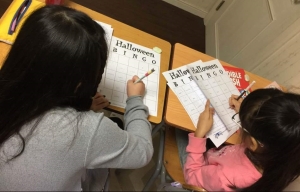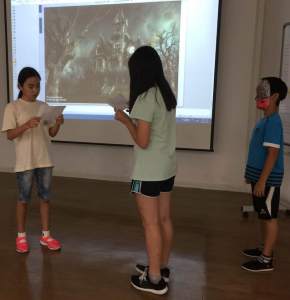When I started this blog a couple of years ago, I vowed to myself that I will never ever abandon it no matter how busy I am… but I couldn’t keep that promise. Now that I’m back to blogging, I feel like I’m in zombie apocalypse. Everything has come to a standstill. My brain refuses to function when I try to organize my thoughts. I can’t figure out how to reply to all the messages and comments that have piled up from last year. My dear readers, I owe you an apology. Here’s a big ghost hug!

This time, I’m going to try to answer SOME of the most frequently asked questions in my blog about teaching in Korea.
Let’s start!
- Can a Filipino teacher work as an English instructor in Korea?

My 5th graders performing a role-play
Yes, but if you’re applying for a teaching job here and you’re currently in the Philippines, there is only one way to obtain a teaching visa. It’s known as the E-1 visa, one that is given to lecturers and university professors. The other teaching visa, the easiest to obtain, which is the E-2 visa, is only given to citizens of one of the following English speaking countries: Australia, Britain, Canada, Ireland, New Zealand, South Africa or United States. No matter how fluent you are in English and how impressive your resume is, if you’re not from any of the countries mentioned, you won’t be given an E2. Yes, the requirement is racial bias and it’s BS… but this is Korea where getting a teaching job is not as easy as pie if you’re not Caucasian-looking.
There are also Filipinos who come here with a student visa (D-2) or training visa (D-4) and teach part-time. This is legal ONLY if you get a written permission from your school or one of your professors.
Other Filipinos who are in Korea under a missionary or religious worker visa (D6) try their luck on teaching, and they succeed; however, the D-6 visa is NOT a teaching visa. This means that if you teach here with a D-6, you’re not teaching legally. Some hagwons may hire you, but only as a part-timer. This is somewhat risky and temporary. I had a colleague who taught English in an academy while she was on a D-6. Eventually, they had to let her go, because she couldn’t be registered as a legal employee.
The easiest way for a Filipino teacher to teach legally in Korea is through the F-6 visa or the F-5 visa. This means that you’ll have to come to Korea as a spouse and/or attain permanent residency here. Most of the Filipinos married to Koreans I know teach in private institutions like hagwons (academies) or public schools. Some of them don’t even have teaching degrees. (They are graduates of other courses.)
I’ve written about this topic five years ago, and the rules haven’t changed. You can read more about it here.
2. How much is the salary?
In hagwons, monthly salaries range from 1.8 to 2.3 million won (around 1,589 to 2,031 USD) if you work full-time. A full-time teacher in Korea should work for at least 30 hours a week. The normal workload is 6 hours a day, 5 times a week. Note, however, that there are private institutions that require teachers to work from Monday to Saturday (for example, some hagwons that have middle school or high school students). If this is the case, you should not work for more than 5 hours a day. Other private institutions will offer non-native speakers lower salaries, but do yourself a favor… don’t settle for less than what you deserve just to have a job. You can always find a hagwon that will treat you fairly.
In public schools, the average monthly salaries for teachers range from 1.5 to 2.6 million won (1,324 to 2,296 USD) depending on credentials. Those with no teaching experience can expect to get somewhere between 2 to 2.3 million won (1,766 to 2,031 USD) . Education majors or licensed teachers can make somewhere between 2.2 to 2.6 million won (1,942 to 2,296 USD). There are some foreigners who claim (or boast) that they are making 3 million won or more, but this is kind of hard to believe, because public schools have a certain budget for foreign teachers. They can’t just offer higher salaries. Universities offer the highest salaries starting from 2.3 to 3.5 million won (1,766 to 3,091 USD). There are even reports that university professors with outstanding credentials can get up to 5 million won (4415 USD).
Private tutors are usually paid per hour. The rate depends on you, of course, but just to give you an idea of what is acceptable, 30,000 to 35,000 won (26 to 31 USD) is good enough. In affluent areas in Korea, you can ask for 40,000 won (35 USD) per hour, 50,000 won or more (44 USD) for business English classes.
3. Is private tutoring legal?
If you’re on E-2 visa, NO. You can take your chances and do it secretly, but if you get caught, you might end up getting fined or deported. It is illegal for an E-2 visa holder to work as a tutor… unless his employer allows it and submits a written permission to the immigration. Also, the income from tutoring should be declared to the tax office, so that the tutor can pay the appropriate taxes.
On the other hand, it is good news for F-6 and F-5 visa holders. Being on a spouse visa or a permanent residence visa gives you more leeway to do any kind of job in Korea including tutoring; however, it is mandatory to report the income, just like with the E-2, and pay taxes.
For D-6 visa holders, there is NO legal way to teach privately.
I’m going to answer more questions next time.
HAVE A HAPPY WEEK! ^^









